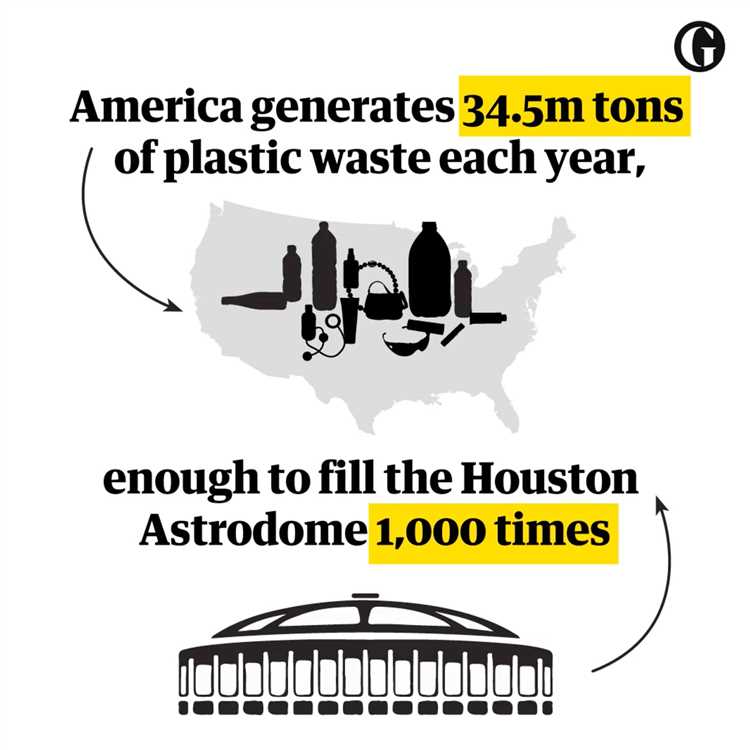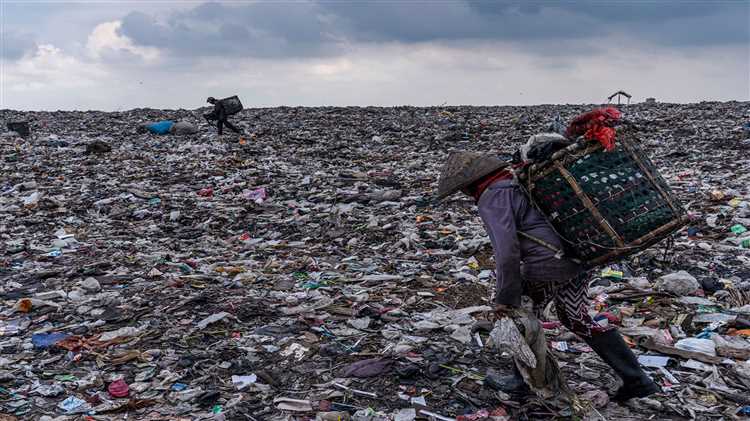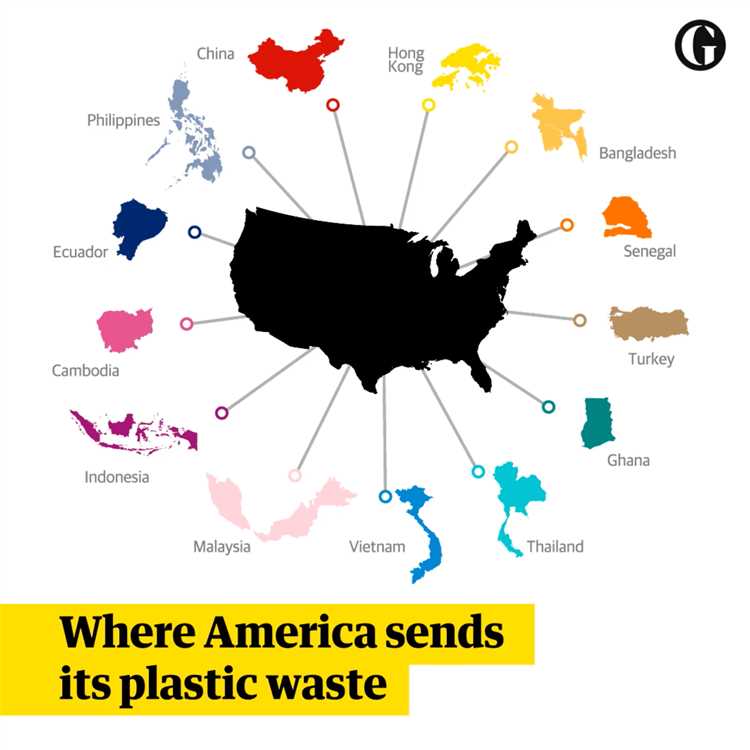
Plastic waste has become a global environmental crisis, and the United States is one of the largest contributors. With its vast production and consumption of single-use plastics, the US generates millions of tons of plastic waste each year. But where does all this plastic go?
Unfortunately, a significant amount of US plastic waste ends up in landfills. Many cities and towns lack the infrastructure and resources to recycle or properly dispose of plastic. As a result, plastic waste often gets buried in landfills, where it can take hundreds of years to decompose. This contributes to the growing problem of plastics polluting our land and waterways.
However, not all US plastic waste stays within the country. A portion of it is exported to other nations, particularly in Asia. These countries, such as China, Vietnam, and Malaysia, have historically imported large quantities of plastic waste from the US for recycling. However, in recent years, many of these countries have implemented stricter import restrictions, leading to a shift in the global plastic waste trade.
The destinations of US plastic waste have shifted to other Southeast Asian countries, such as Indonesia, Thailand, and India, where recycling industries continue to accept imported plastic waste. Unfortunately, not all of this plastic waste is properly recycled. Some of it ends up being illegally dumped or burned, causing further harm to the environment and human health.
In conclusion, the destinations of US plastic waste vary, with a significant amount ending up in landfills within the country and a portion being exported to other nations. The global plastic waste crisis calls for urgent action to reduce plastic consumption, improve recycling infrastructure, and develop sustainable alternatives to plastic.
- Exporting Plastic Waste: The Global Market
- The Role of China: A Changing Landscape
- New Policy Initiatives
- Emerging Markets
- Asia’s Rising Demand: Plastic Waste Imports
- South Asian Countries: Growing Receivers of Plastic Waste
- Developing Nations: Coping with Plastic Waste Import
- The Environmental Impact: Plastic Waste Disposal
- Questions and answers:
- What is the current situation with plastic waste in the United States?
- Where does the United States export its plastic waste?
- Why does the United States export its plastic waste instead of recycling it domestically?
- What are the environmental consequences of exporting plastic waste?
- Are there any efforts being made to reduce the export of plastic waste from the United States?
Exporting Plastic Waste: The Global Market

As the United States grapples with the growing problem of plastic waste, a significant amount of that waste is being exported to other countries around the world. The global market for plastic waste has become a booming industry, with countries like China, Malaysia, and Vietnam becoming major destinations for US plastic waste.
One of the main reasons for exporting plastic waste is the cost. Many developing countries have lower labor costs and fewer regulations, making it cheaper to process and recycle plastic waste. In addition, these countries have a high demand for raw materials, making them willing to import and process plastic waste for use in manufacturing.
However, exporting plastic waste is not without controversy. In recent years, there have been concerns about the environmental and health impacts of exporting plastic waste to developing countries. Poor waste management practices and lack of proper infrastructure in some of these countries can lead to pollution of waterways and soil, as well as health risks for local communities.
Some countries have started to take action to address these concerns. China, for example, used to be the largest importer of US plastic waste, but in 2018, it implemented a ban on imports of several types of plastic waste. This has led to a shift in the global market, with other countries like Malaysia and Vietnam stepping in to fill the gap.
- Malaysia has seen a surge in plastic waste imports in recent years, with some experts raising concerns about illegal dumping and inadequate recycling facilities.
- Vietnam has also seen a rise in plastic waste imports, leading to similar environmental and health concerns.
As the global market for plastic waste continues to evolve, it is clear that addressing the problem of plastic waste requires a global solution. International collaboration and regulation are necessary to ensure that plastic waste is managed and recycled in a sustainable and responsible manner.
The Role of China: A Changing Landscape

For many years, China has been a major destination for US plastic waste. Its large manufacturing sector and low labor costs made it an attractive option for US companies looking to export their plastic waste. However, in recent years, the landscape has started to change.
New Policy Initiatives
In 2018, China implemented a new policy known as the National Sword, which banned the import of certain types of solid waste, including many types of plastic waste. This policy was implemented in an effort to reduce pollution and improve the country’s environment. As a result, China went from being the largest importer of US plastic waste to virtually shutting its doors overnight.
This shift in policy had a significant impact on the recycling industry in the United States. With China no longer accepting plastic waste, US companies were left with a surplus of material and limited options for disposal. Many recyclers were forced to stockpile or landfill their plastic waste, leading to increased costs and environmental concerns.
Emerging Markets
As a result of China’s ban, other countries in Southeast Asia, such as Malaysia, Vietnam, and Thailand, have emerged as new destinations for US plastic waste. These countries have seen a surge in imports of plastic waste, as US companies seek alternative markets for their materials.
However, this shift in waste flows also presents new challenges. Many of these emerging markets lack the infrastructure and regulations necessary to handle the influx of waste. As a result, there are concerns about increased pollution and environmental degradation in these regions.
The changing landscape of US plastic waste destinations highlights the need for greater investment in domestic recycling infrastructure. As the global market for plastic waste continues to evolve, it is important for the United States to develop more sustainable and self-reliant solutions for managing its own waste.
In conclusion, China’s decision to ban the import of plastic waste has had a significant impact on the global recycling industry. While other countries have taken up some of the slack, there are still challenges to be addressed. It is clear that the future of plastic waste management lies in developing more sustainable solutions at home.
Asia’s Rising Demand: Plastic Waste Imports
Asia, particularly countries in East and Southeast Asia, has been experiencing a significant rise in demand for plastic waste imports in recent years. The region has become a major destination for the disposal of plastic waste from countries like the United States.
One of the main factors driving this increase in demand is the growing manufacturing sector in Asia. As the region’s economies continue to develop, their need for raw materials has also increased. Plastic waste can be recycled and used as a source of raw materials for various industries.
In addition, the relatively low labor and environmental regulations in some Asian countries have made it cheaper and easier for countries to export their plastic waste. This has attracted waste management companies and recycling facilities to set up operations in these countries, in order to take advantage of the lower costs and lax regulations.
- China, in particular, was the largest importer of plastic waste for many years. However, in 2018, the country implemented a ban on the import of certain types of plastic waste, as part of its efforts to reduce pollution and improve environmental conditions.
- Following China’s ban, other Asian countries like Malaysia, Vietnam, and Thailand emerged as major importers of plastic waste, as they had fewer restrictions on imports compared to China. These countries have experienced a surge in imports of plastic waste, often exceeding their capacity to handle and process it.
- Concerns about environmental pollution and the impact of plastic waste imports on local communities have been raised in some of these countries. There have been reports of illegal dumping and improper disposal of plastic waste, which has led to contamination of land and water sources.
The rise in Asia’s demand for plastic waste imports has highlighted the need for more sustainable and responsible waste management practices. Both exporting countries and importing countries need to work together to develop better recycling infrastructure, enforce stricter regulations, and promote the use of alternatives to single-use plastics.
Efforts are being made to address these issues, including discussions at international forums and collaboration between governments, waste management companies, and environmental organizations. It is crucial to find solutions that not only address the immediate challenges surrounding plastic waste imports but also promote long-term sustainability and a circular economy for plastics.
South Asian Countries: Growing Receivers of Plastic Waste
In recent years, South Asian countries have emerged as leading destinations for US plastic waste. This region, which includes countries such as India, Bangladesh, Pakistan, and Sri Lanka, has seen a significant increase in the import of plastic waste from the United States.
There are several reasons why South Asian countries have become attractive receivers of plastic waste. Firstly, the low labor and operating costs in these countries make it cheaper to process and recycle plastic waste compared to the United States.
Additionally, the lack of strict regulations and enforcement regarding waste management in South Asian countries makes it easier for them to accept and handle large quantities of plastic waste. This has led to an influx of plastic waste imports, as the region provides a conveniently low-cost solution for countries looking to dispose of their plastic waste.
However, the growing influx of plastic waste has also raised environmental concerns in South Asian countries. Improper disposal and management of plastic waste can lead to pollution of water bodies, soil, and air, negatively impacting the health of local communities and ecosystems.
Efforts are being made to address these environmental issues, with calls for stricter regulations and improved waste management practices. Some South Asian countries have implemented bans on plastic waste imports or have set limits on the types and quantities of plastic waste that can be imported.
Overall, the increasing trend of South Asian countries receiving plastic waste from the US highlights the need for global cooperation and sustainable solutions to tackle the growing issue of plastic waste pollution.
Developing Nations: Coping with Plastic Waste Import
As the demand for plastic waste disposal increases, developing nations are facing challenges in dealing with the import of plastic waste. These nations often lack the infrastructure and resources to properly manage and dispose of such waste, leading to environmental and health risks.
Plastic waste import has become a significant issue for many developing nations, particularly in Southeast Asia and Africa. These regions receive large quantities of plastic waste from developed countries, often labeled as recycling material. However, a lack of strict regulations and enforcement allows for the illegal dumping and improper handling of this waste.
The import of plastic waste has severe consequences for developing nations. It can contaminate water sources, pollute the air, and harm local ecosystems. The improper disposal of plastic waste can also affect human health, leading to respiratory problems, diseases, and even death.
To cope with the plastic waste import, developing nations are implementing various strategies. Some countries have started banning or restricting the import of plastic waste altogether. Others are investing in recycling facilities and waste management infrastructure to handle the growing problem.
International collaboration plays a crucial role in addressing this global issue. Developed nations must take responsibility for their plastic waste and work towards reducing reliance on plastic consumption. They should also support developing nations in improving their waste management systems and implementing effective regulations.
Overall, the import of plastic waste poses significant challenges for developing nations. It is essential to prioritize sustainable waste management practices and promote responsible plastic consumption to address this growing problem.
The Environmental Impact: Plastic Waste Disposal
The disposal of plastic waste has significant environmental implications. Plastic takes hundreds of years to break down and decompose, leading to long-lasting pollution in landfills and natural environments. This pollution poses a threat to both wildlife and human health.
When plastic waste is not properly disposed of, it can end up in waterways such as rivers and oceans. This leads to the contamination of freshwater and marine ecosystems, negatively impacting aquatic life. Marine animals, such as turtles, fish, and seabirds, can become entangled in plastic debris or mistake it for food, which can result in injury or death.
Furthermore, the burning of plastic waste releases harmful toxins and greenhouse gases into the atmosphere. This contributes to air pollution and climate change. The improper incineration of plastic waste also creates ash residue that may contain heavy metals, which can contaminate soil and water sources.
In addition to the direct environmental impact, plastic waste disposal also has indirect consequences. The production and transportation of plastic packaging and products contribute to the consumption of fossil fuels and the emission of greenhouse gases. Additionally, the disposal of plastic waste requires land for landfills or incineration facilities, which can contribute to deforestation and habitat destruction.
To mitigate the environmental impact of plastic waste disposal, it is crucial to prioritize recycling and waste reduction efforts. Recycling plastic waste can help conserve resources, reduce energy consumption, and decrease pollution. Governments and organizations should also invest in research and innovation to develop sustainable alternatives to plastic packaging and promote circular economy practices.
- Improve recycling infrastructure and accessibility.
- Implement policies to reduce single-use plastics.
- Educate the public about the importance of proper plastic waste disposal.
- Support advancements in plastic waste management technologies.
- Encourage businesses to adopt sustainable packaging solutions.
- Invest in research and development of biodegradable and compostable plastics.
By taking these steps, we can minimize the environmental impact of plastic waste disposal and work towards a more sustainable future.
Questions and answers:
What is the current situation with plastic waste in the United States?
The United States produces a vast amount of plastic waste, with much of it ending up in landfills. However, a significant portion is also exported to other countries for recycling or disposal.
Where does the United States export its plastic waste?
The United States exports its plastic waste to various countries around the world, including China, Canada, and Mexico. However, the destinations have shifted in recent years due to changes in recycling policies.
Why does the United States export its plastic waste instead of recycling it domestically?
The United States exports its plastic waste because it is often more cost-effective to do so. Recycling processes can be expensive, and exporting the waste allows the country to take advantage of lower labor and operational costs in other countries.
What are the environmental consequences of exporting plastic waste?
The environmental consequences of exporting plastic waste can be significant. It can lead to pollution in the receiving countries, as not all of the waste may be properly recycled or disposed of. Additionally, the transport of the waste across long distances contributes to carbon emissions.
Are there any efforts being made to reduce the export of plastic waste from the United States?
Yes, there are efforts being made to reduce the export of plastic waste from the United States. This includes the implementation of stricter recycling policies and a push for more domestic recycling infrastructure. However, progress has been slow, and systemic changes are needed to effectively address the issue.